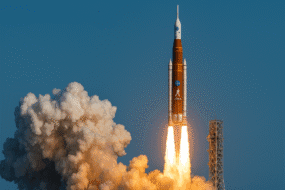India’s Chandrayaan-3 Finds Signs of Ancient Lunar Mantle at Moon’s Shiv Shakti Point
India’s Chandrayaan-3 mission has made a significant scientific breakthrough at the Shiv Shakti Point near the Moon’s south pole, offering new insights into the Moon’s early geological history.
The Pragyan rover, equipped with the Alpha Particle X-ray Spectrometer (APXS), detected low sodium and potassium levels and elevated sulfur concentrations in the soil. This composition is dramatically different from samples collected by earlier lunar missions such as Apollo, Luna, and Chang’e.
🔍 Key Findings:
- Sulfur Enrichment: The southern high-latitude soils are rich in sulfur, more than any other highland site studied so far.
- Not Surface-Originated: High daytime temperatures at this location rule out surface-based sulfur condensation or meteoritic sources.
- Deep Origins: Scientists at Ahmedabad’s Physical Research Laboratory (PRL) suggest the materials were excavated from the primitive lunar mantle following the South Pole–Aitken (SPA) basin impact around 4.3 billion years ago.
🌕 Geological Significance:
The materials predate the KREEP (potassium, rare-earth elements, and phosphorus) layer formation found in the Procellarum KREEP Terrane (PKT), where most prior lunar missions were focused. The data supports the lunar magma ocean hypothesis, indicating that the Moon’s crust was formed when plagioclase crystals floated to the surface during magma cooling.
The SPA impact likely exposed:
- Ferroan anorthosite from the upper crust
- Magnesium-rich Mg-suite rocks from the lower crust or upper mantle
This unique geochemical signature makes Shiv Shakti Point one of the most valuable non-PKT locations for studying the Moon’s deep interior.
🚀 Implications for the Future:
This is the first volatile element analysis from a non-PKT region, challenging long-standing theories about lunar composition. Moreover, the sulfur-rich materials may play a role in future lunar infrastructure, potentially supporting in-situ resource utilization (ISRU) strategies.
Chandrayaan-3’s success highlights India’s growing contribution to lunar exploration, supplying the world with fresh data crucial for understanding the Moon’s formation—and for planning long-term human presence on its surface.
















